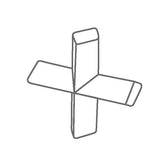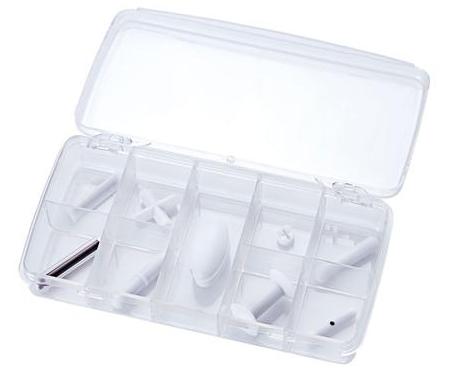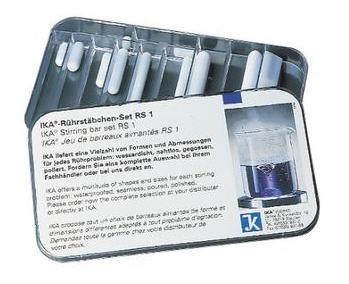Using a magnetic stirrer requires little setup and is a convenient option, especially when it comes to low viscosity fluid mixing. Although the setup is simple, you do have some decisions to make, one being which stir bar (also known as a stirring flea) to use. These differ in size, shape, and material, and there are actually a lot of options to consider.
In this post, we’ll help you answer some common questions so you can choose the right bar for your needs.
Which Shape of Stir Bar Should You Use?
There are many shapes of stir bar available, each suitable for different applications, as described in the table below.
|
Round |
 |
This is a common type of stir bar and is suitable for various applications, usually with flat-bottomed vessels. |
|
Slide Round |
 |
These ones have a pivot ring around the center. They are designed to maintain the optimum position in vessels with curved or uneven bottoms. The ring helps to reduce vibrations and wear, and reduce the effects of friction from contact with the vessel. |
|
Ball (Spherical) |
 |
These are often used for small volumes in vessels such as tubes and vials. |
|
Oval (Ellipse) |
 |
Oval or ellipse-shaped stirring bars are ideal for ensuring homogeneous mixing in round-bottomed beakers. |
|
Cross |
 |
This type is good for stable stirring at high speeds. The cross shape results in additional turbulence for better mixing. The bar sits at the bottom of the vessel, so can also be good for stirring up sedimentation. |
|
Crown (Crosshead) |
 |
Crown-shaped stir bars can be ideal for use in a cuvette or test tube. They can be used in other containers as well, so might be a good option if you need to switch between two types. |
|
Bone |
 |
The unique shape of these bars enables them to create a large amount of turbulence at low speeds. They are ideal for use in vessels with arched bottoms and provide high stability. |
|
Triangle (Prism) |
 |
These bars can provide lots of turbulence even at slow speeds. The shape means they can act as a scraper, so they’re good for helping with dissolution or preventing sedimentation. |
Images used in this table are sourced from IKA.
Stir bars are sometimes available in sets of different shapes, like the one below.

IKA’s RS 2 Set of magnetic stirring bars.
What Size Stir Bar Is Best?
When selecting the right size bar for your application, here are the major factors to consider:
The Volume of Fluid You’re Stirring
For smaller volumes and vessels, the bar needs to be small enough that it won’t touch the sides of the vessel while spinning. For larger volumes, you’ll want to go with a larger stir bar. This will result in more motion and increase the efficiency of mixing.
The Vessel Shape and Opening Size
The shape and opening size of the vessel could have an impact of the size of the stir bar you choose. For example, for a round-bottomed flask, even if the widest diameter of the vessel is relatively large, a smaller bar will be required to ensure there is no catching on the sides of the flask near the bottom.
Some vessels may have very small openings resulting in a desired bar not being able to fit. While this is rare considering the small size of most bars, if it does happen, you may need to go smaller.
The Size of the Internal Drive Magnet
The size of the magnet inside the stirrer, which may be referred to as the drive magnet, is of great importance when choosing a stir bar size. The length of the bar should be about equal to the magnet size to avoid spinout. Spinout occurs when the bar loses its coupling with the internal magnet of the stirrer and the bar stops spinning altogether.
Stir bars significantly longer than the internal magnet might reduce the max speed the bar may be spun. This increases drag without providing proportionately stronger magnetic coupling.
Some manufacturer specifications will tell you the maximum recommended length for a stir bar used with the magnetic stirrer.
Manufacturer specifications for an IKA Topolino magnetic stirrer.
Stir bars sometimes come in sets including different sizes, such as the one below.

IKA’s RS 1 Set of magnetic stirring bars.
What Material Should the Stir Bar Be?
A stir bar consists of two major components, the actual magnet and the coating. Materials can vary for both.
Magnetic Component
The magnetic component is typically made of ALCINO, an alloy of aluminum (Al), Nickel (Ni), and cobalt (Co), which is suitable for most applications. There are some stir bars available that use samarium cobalt, which will offer stronger coupling with the internal magnet of the stirrer and reduce the chance of the bar spinning out. These bars allow for greater torque and can be useful in applications where you have large volumes or high viscosity liquids.
Coating
Stir bars are typically coated with PTFE, which can resist high temperatures and is generally chemically inert. For very high temperature applications, and applications where PTFE is not chemically compatible, there are glass-coated options available. These are also suitable for use with highly abrasive materials.
Tips for Using a Stir Bar
Once you’ve selected the right bar, here are a few tips to make sure you get the best results.
- To allow for optimal coupling, choose a vessel with a thin bottom to minimize the distance between the bar and the drive magnet.
- Position the vessel in the middle of the stirrer plate and place the stir bar in the center of the vessel. This will help with coupling and to avoid having the stir bar catch on the side of the vessel.
- Increase the stirring speed slowly to avoid spinout.
As you can see, there are a lot of factors to consider when it comes to choosing the appropriate stir bar for your application. But you may not always have the luxury of all of these options. In practice, you might have to simply make do with what is at hand. However, now that we’ve explained the main elements to take into account, you should be well-equipped to make an informed choice, no matter what is available.

